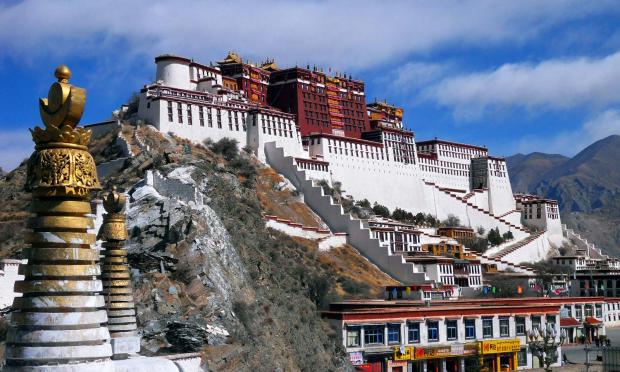he 23rd of May, 1951 heralded the most unfortunate epoch in the history of Tibet where the Chinese Communist Party (CCP) occupied Tibet on the false pretext of a so-called “Peaceful Liberation” — liberation based on forgery of a document called “17 Point Agreement”. To mark the occasion of its 70th anniversary, on 21st of May, the CCP issued a White Paper dubbed as “Tibet since 1951: Liberation, Development and Prosperity” which is yet another attempt to legitimize the so-called “17 Point Agreement” and sell the CCP’s self-manufactured narratives on ‘Tibet as an inalienable part of China’. The paper implicitly touches upon three main issues:
1. The paper completely neglects the historical status of Tibet, manufactures a fictional narrative of Tibetan history, and legitimizes the so called “17 Point Agreement”;
2. Second, the CCP’s alleged ongoing poverty alleviation is used as a cloak to overshadow brutality and the repressive policies being perpetrated in Tibet and East Turkestan;
3. Lastly, the CCP wants to convince the world that they have the right to choose the next Dalai Lama.
Hence, this paper is a repository of the CCP’s lies and worries. As the world continues to harden its stance against the CCP, China’s falsehoods are growing weaker in their persuasive abilities.
Debunking the Paper and Exploring Tibet’s Historical Status
The CCP claims that Tibet was a part of China since time immemorial. Their narrative doesn’t end there. They also claim that Tibet became a part of China owing to matrimonial relations being established through Tibet’s 33rd King Songtsen Gompo’s marriage to a Chinese princess. To debunk those narratives, the late Ngabo Ngawang Jigme stated the following statement:
“Some historians claim that Tibet had been a part of China from antiquity, some others claim since the time of Tibetan king Songtsen Gampo through his marriage to the Chinese princess. I do not agree with both these views. When you talk about antiquity, there is no time line; or if it is from the time of Songtsen Gampo’s marriage, we all know that the first queen of Songtsen Gampo was Nepal’s princess in which case Tibet should be part of Nepal. How can we explain this?”
The white paper does not have an explanation nor Tibet’s internationally recognized early and modern history. The Sino-Tibetan Treaty of 821 A.D. was one of the most prominent treaties which demarcated a clear border between Tibet and China. The treaty was inscribed on a pillar at the Jokhang in Lhasa which states, “Tibet and China shall abide by the frontiers of which they are now in occupation. All to the east is the country of great China; and all to the west is, without question, the country of great Tibet. Henceforth, on neither side shall there be waging of war nor seizing of territory.” The white paper doesn’t care about omitting such a historic treaty. Tibetan history is full of such interactions which provide ample and unambiguous proofs of its sovereignty, regardless of CCP’s fabricated narratives.
Though Tibet has had a national flag since 1916, her national flag made its first international appearance in 1934. It was among the ‘Flags of the World’ — a compilation of national flags by the National Geographic Magazine.According to Jamyang Norbu,90% of the flags of the nations in UN were created after WWII, including the present national flag of China. Even internationally renowned vexillologist Professor Lux-Worm believes that “the national flag of Tibet was based on an older 7th century snow lion standard of the Tibetan King, Songtsen Gampo.”
In modern memory, Tibetan national flag’s first official international debut was made at the Asian Relations Conference held in New Delhi in 1947. The Tibetan national flag was displayed in a circular emblem before the Tibetan delegates’ podium. If the CCP’s white paper doesn’t include these historical facts, then what remains of the credibility of their fabricated narratives? The same paper is a strategy to bury the historical status of Tibet under sheets of lies and promote their propaganda.
The So-Called 17 Point Agreement
The so-called 17 Point Agreement (hereinafter “the Agreement”) is the principal pretext on which the CCP occupied Tibet through force. Yet, they call it a “peaceful liberation”. The Tibetan delegation led by late Ngabo Ngawang Jigme was not given the “plenipotentiary authority to conclude an agreement”. They were just instructed to inform all the important matters to the government. It shows that they didn’t have the full authority to accept an agreement on behalf of Tibetan Government. Yet, the CCP, with all its wits, compelled Tibetan delegates to sign the agreement under duress. The fabrication of the agreement itself is contrary to the CCP’s narrative on Tibet. The first clause of the agreement says:
The people of Tibet shall unite and drive out aggressive imperialist forces; they will return to the family of the People's Republic of China.
Since the CCP insists that Tibet was a part of China since time immemorial, then why did they ask the ‘return’ of Tibet to China? This act alone shows the intention of the agreement and the screaming perfidy of the term “peaceful liberation”. To one’s surprise, even the seals affixed to the document were forged. If the very modus operandi of the Agreement was a forgery, one can presage the integrity of its implementation.
The 3rd point of “the Agreement” says, “The Tibetan people have the rights to exercise national regional autonomy under the unified leadership of the Central People’s Government”. If Tibetan people have the rights to exercise national regional autonomy, why did the CCP divide the traditional three regions of Tibet into five regions in 1965? Why only the Tibet Autonomous Region was granted a modicum of autonomy (albeit a veiled lie)? Is the so-called “the Agreement” only for the TAR?
The 4th point of “the Agreement” says, “The central authorities will not alter the existing political system in Tibet. The central authorities also will not alter the established status, functions and powers of the Dalai Lama”. The root cause of the 1959 Tibetan national uprising was due to a Chinese plot to kidnap His Holiness the XIVth Dalai lama. Tibetans from all three traditional regions gathered in front of the Norbulingka Palace to resist the CCP’s execution of the plot. This plan shows the duplicity of the 4th point. Even the 10th Panchen Lama was imprisoned for his 70,000 character petition in 1962. The Chinese have subsequently spread their tentacles of a repressive administration, backed by a sea of Chinese forces and migrants.
The 7th point of “the Agreement” says, “The religious beliefs, customs and habits of the Tibetan people shall be respected, and Lama Monasteries shall be protected.” The CCP’s actions went complete against the point stipulated in “the agreement” by destroying 98% of Tibetan monasteries and disrobing 99.9% of Tibetan monks and nuns. In recent years, the demolition of Larung Gar Monastery is a prime example that how the CCP upholds “the agreement”. Even remaining monasteries in Tibet are not in a great shape- the Chinese command them to compromise upon their culture and religion, as China continues in its quest to forcefully Sinicize Tibet.
From these points, it is crystal clear that CCP never intended to implement the points stipulated in “the Agreement”. Even Dr. Michael van Walt van Praag — a distinguished international lawyer — summed up the reality of “the Agreement” as follows:
There is no question that under international law the 17-point Agreement never had any validity. Treaties and similar agreements concluded under the use or threat of force are invalid under international law ab initio (Vienna Convention on the Law of Treaties, Article 521).
Under no circumstances could this agreement legitimize the peaceful liberation of Tibet at any degree. The very modus operandi was forged; the points mentioned in the agreement were never respected and it didn’t serve the aspiration of Tibetans.
Poverty Alleviation and Reincarnation
The paper claims “A complete victory over poverty”. The CCP thinks that poverty alleviation could be used as an alternative to western development models. The very idea is to impress western countries and legitimize their rule in Tibet and East Turkestan. The TCHRD’s latest report holds a similar view that the CCP’s poverty alleviation campaigns are mainly focused in Tibet and East Turkistan. In Tibet, poverty alleviation is done by relocating, sometimes forcefully, rural people into urban areas and bring about a change of lifestyle. The ultimate aim is to eradicate the traditional lifestyles of Tibetans and re-educate Tibetan living in urban to obey the motherland called ‘China’. In the paper, under ‘A complete victory over poverty’, there are lots of statistics indicating the success of CCP’s poverty alleviation but who would dare question the authenticity of the statistics and figures?
The paper also fabricates how the CCP has the historical authority of choosing the reincarnation of Dalai Lamas by citing how they used to give honorific titles to Dalai Lama and Panchen Lama. If a lie has boundary, CCP never hesitates to cross it at any cost. The whole fabrication is mainly targeted to non-Tibetans who have a minimal understanding of Tibetan history and the lineage of the Dalai Lamas in particular. Chairman Mao once said, “Religion is poison” and gave the following reasons:
It has two great defects: it undermines the race, and secondly it retards the progress of the country.
If the CCP wants to choose the next Dalai Lama, it will surely undermine their race and affect the progress of the nation. So, it is better to uphold the views of Chairman Mao than poke their nose into the Tibetan Buddhists’ business. Here, it is more apt to say, “It’s not your business”. Regarding the CCP’s intervention in choosing the next Dalai Lama, the Sikyong-elect Penpa Tsering categorically stated that if Beijing wants to choose the next Dalai Lama, they have to learn Buddhism first. No matter how hard the CCP tries to control over the selection of the next Dalai Lama, the world wouldn’t stay mute over this matter because a Chinese puppet Dalai Lama won’t bring peace, love, and compassion on this earth. Merely calling someone a Dalai Lama has little weight- it is belief, credibility, and the divine order of things which make a Dalai Lama.
Conclusion
The paper is comprised of 10 major sections with 15,323 words, but the substance of the paper contains only three things. First, it buried Tibet’s historical status and tries to legitimize the peaceful liberation of Tibet on the pretext of the so-called “The 17 Point Agreement” which was signed under duress on 23rd May, 1951. To prove to the world that the CCP is successfully handling the Tibetan issue, they came out with this particular paper. Second, the CCP leaves no stone unturned to impress western nations by boasting poverty alleviation in Tibet and East Turkestan. It is a mechanism to overshadow the brutality and repressive policies implemented in these two occupied territories. Lastly, the CCP wants to convince the world that they have the sole responsibility to choose the next Dalai Lama. All these points considered together; this white paper is no surprise at all. China’s lies are sweet to hear, but drenched in blood and tears.
(Yeshi Dawa is Former Academic Administrator of ILG at the Maharaja Sayaji Rao University, Baroda. He is currently an Affiliated Fellow at the Tibet Policy Institute and Anchor at Tibet TV. Reach him through us at [email protected])















